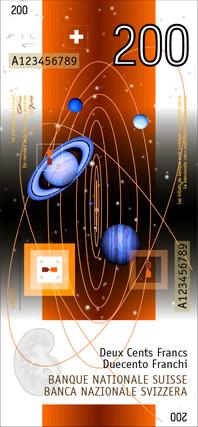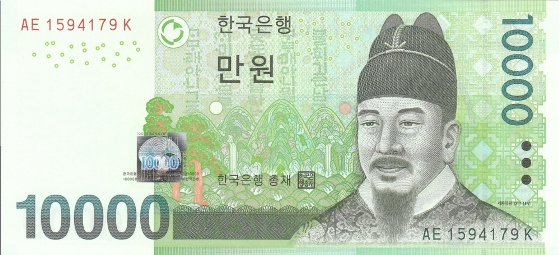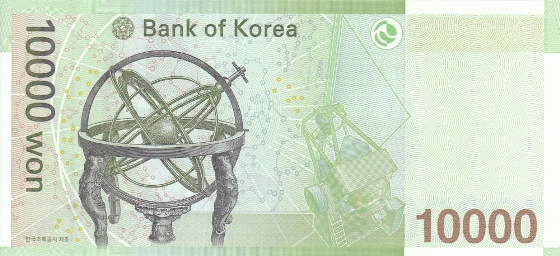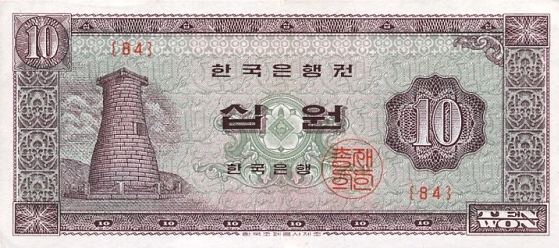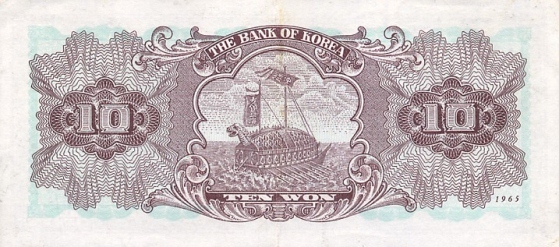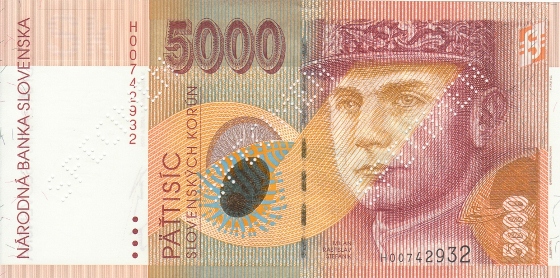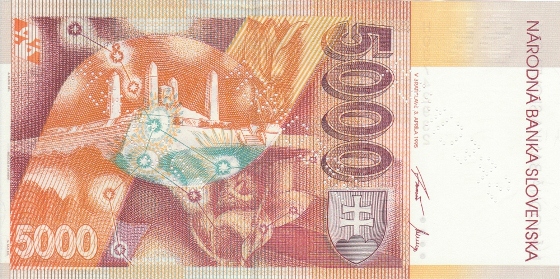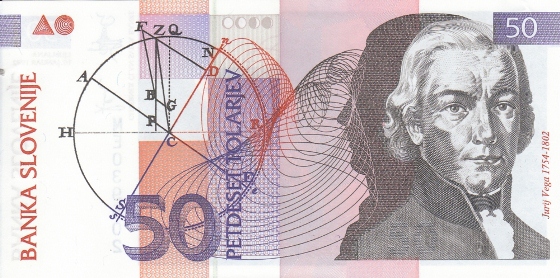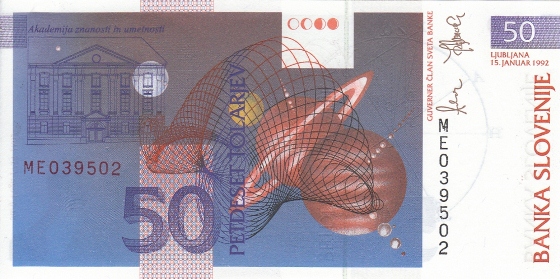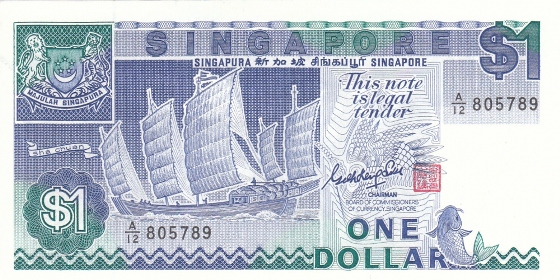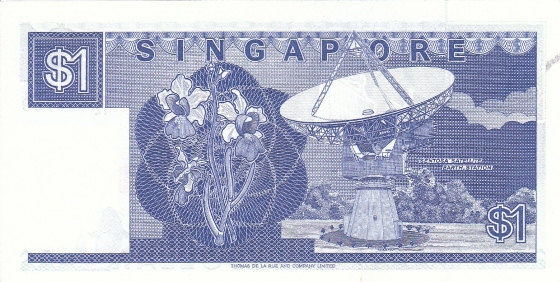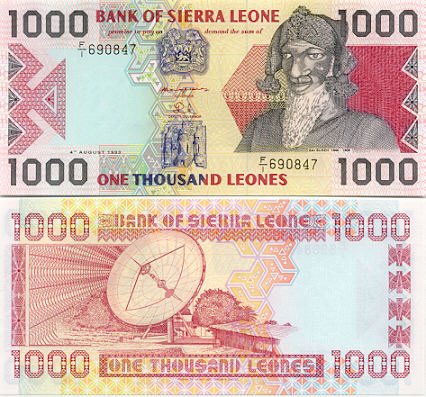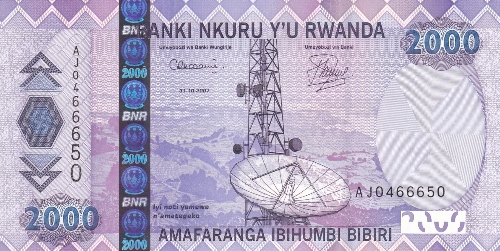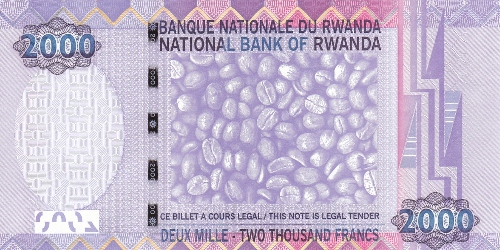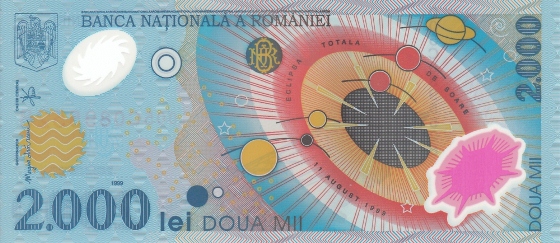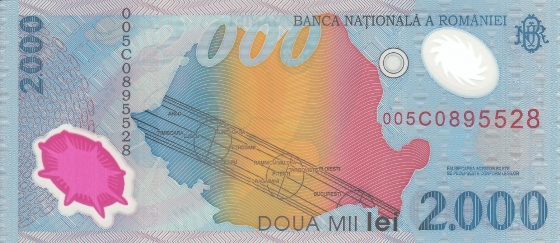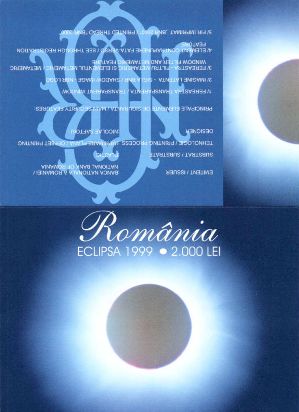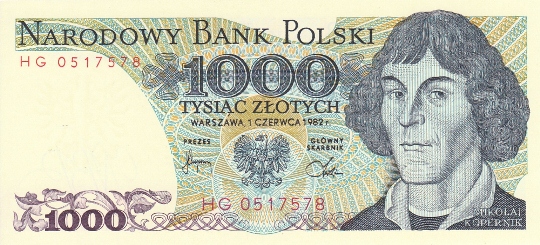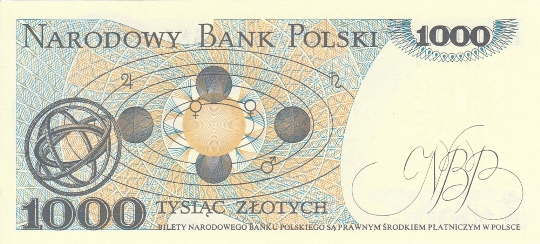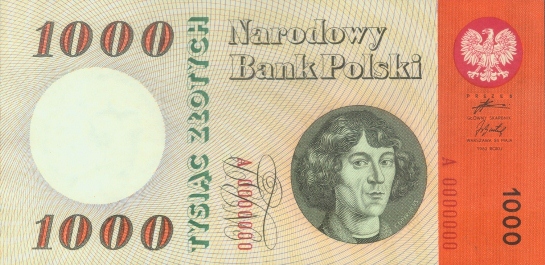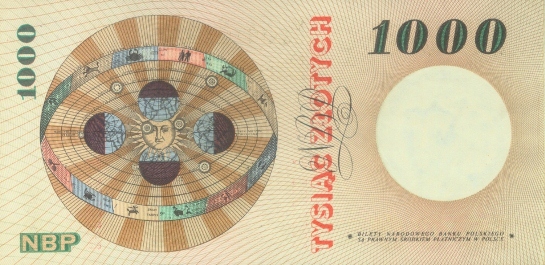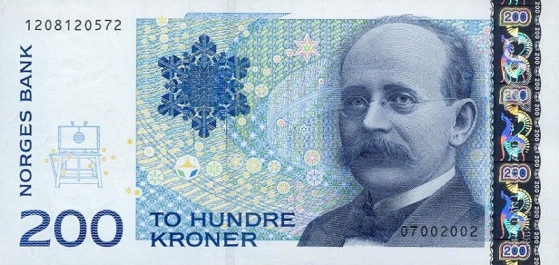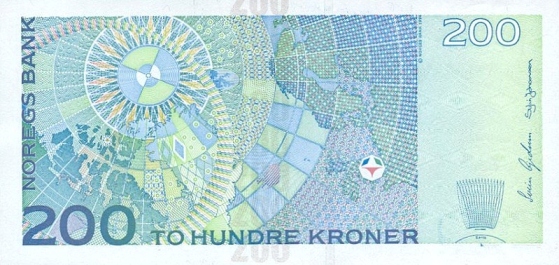Tunisia - 10 dinars - 2005 - P90
This 10 dinars note from Tunisia shows the El Abidine Mosque in Carthage on the front as well as a portrait of the Phoenician princess Elyssa, founder of Carthage. The back shows a satellite dish next to the Roman ruins in Dougga, linking the past and present of Tunisia.
Thailand - 50 baht - 2004 - P112
Thai banknotes usually honour the present and past monarchs. This 50 baht note has the present King Bhumibol Adulyadej in the uniform of the Supreme Commander of the Armed Forces on the front. The back shows King Mongkut (1804-1868), who is most famous in the West for being the king depicted in the movie "The King and I". His full name is Phra Bat Somdet Phra Poramenthra Maha Mongkut Phra Chom Klao Chao Yu Hua, so let's stick to King Mongkut.
During his reign, the pressure of Western expansionism was felt for the first time in Siam. Mongkut embraced Western innovations and initiated the modernization of Siam, both in technology and culture, earning him the nickname "The Father of Science and Technology" in Siam. On the banknote we can see a telescope as a symbol of this scientific attitude.
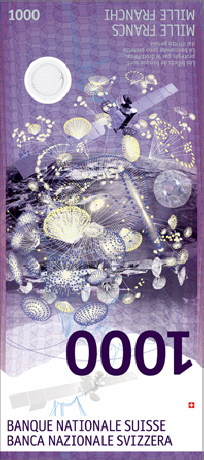
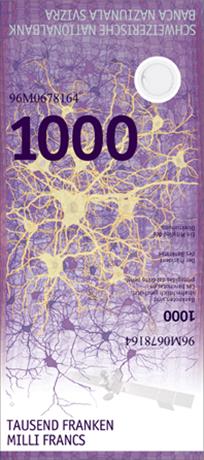 These Swiss 1000 francs notes are part of a series which has been chosen by the Swiss National Bank as the new series of banknotes for the future. The final design will however be a little different from the one proposed here by designer Manuela Pfrunder. In this note we can see a satellite but if this will still be present in the final design is unknown at this moment. The final design won't be shown until shortly before the release of the new series (in 2015 at the earliest). The rest of the series by Pfrunder can be viewed here.
These Swiss 1000 francs notes are part of a series which has been chosen by the Swiss National Bank as the new series of banknotes for the future. The final design will however be a little different from the one proposed here by designer Manuela Pfrunder. In this note we can see a satellite but if this will still be present in the final design is unknown at this moment. The final design won't be shown until shortly before the release of the new series (in 2015 at the earliest). The rest of the series by Pfrunder can be viewed here.
It is however remarkable to know that this wasn't the winner of the design competition: she won the 2nd prize behind winner Manuel Krebs. His entire series can be seen here. But I would like to point specifically to his beautiful 200 francs note:
Switzerland - 10 francs - 1981 - P53
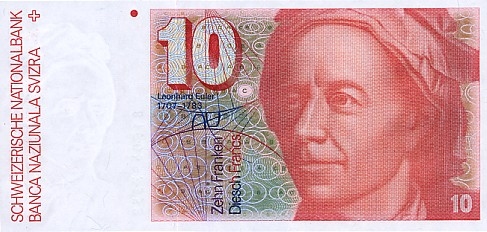
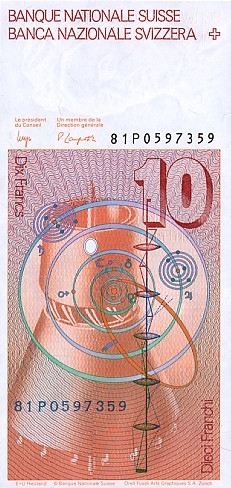
This Swiss 10 francs banknote depicts the Swiss mathematician and physicist Leonhard Euler (1707-1783). He made important discoveries in fields as diverse as infinitesimal calculus and graph theory. He also introduced much of the modern mathematical terminology and notation, particularly for mathematical analysis, such as the notion of a mathematical function. He is also renowned for his work in mechanics, fluid dynamics, optics, and astronomy. His accomplishments in astronomy include determining with great accuracy the orbits of comets and other celestial bodies, understanding the nature of comets, and calculating the parallax of the sun. In addition, Euler made important contributions in optics. He disagreed with Newton's corpuscular theory of light in the Opticks, which was then the prevailing theory. His 1740s papers on optics helped ensure that the wave theory of light proposed by Christiaan Huygens would become the dominant mode of thought, at least until the development of the quantum theory of light.
The back of the note shows a water turbine, the solar system and a scheme of propagation of rays of light passing through lenses.
South Korea - 10,000 won - 2007 - P56
The front of this 10,000 won note from South Korea shows Sejong the Great (1397-1450), the fourth king of the Joseon Dynasty and the creator of the Hunminjeongeum (the Korean script). The back shows the Honcheonsigye. This is an armillary sphere (a spherical astrolabe) of an astronomical clock that's located in front of the statue of king Sejong. We can also see an observatory telescope. In the background is the Cheonsang Yeolcha Bunyajido: a 14th-century Korean star map in the Joseon Dynasty.
South Korea - 10 won - 1965 - P33
The front of this 10 won banknote from South Korea shows Cheomseongdae, the astronomical observatory in Gyeongju. The name literally means "Star Gazing Tower." Cheomseongdae is the oldest surviving observatory in East Asia. It dates to the 7th century to the time of kingdom of Silla, which had its capital in Gyeongju.
Slovakia - 5000 korun - 1995-2003 - P29/33/40/43
This beautiful note shows on the front an image of Milan Rastislav Štefánik, a Slovak politician, diplomat, and astronomer. He graduated in 1904 with a doctor’s degree in philosophy and with thorough knowledge of astronomy (he finished his studies with a thesis in astronomy). He wrote his thesis about a star which was discovered in the Cassiopeia constellation in 1572. In 1904, he went to Paris to find a job in astronomy with the recommendation of a Czech professor who was known in Paris. Initially, he had no money and no command of French, but was nevertheless able to obtain a job at the famous Observatoire de Paris-Meudon, whose director, Pierre Janssen (one of the co-founders of astrophysics), saw Štefánik’s talent. Štefánik owed to Janssen and Camille Flammarion his social, political and scientific career. The observatory was the most important centre for astronomy at this time which meant a huge prestige in his job.
Since 1908, he had been charged by the French authorities with astronomic and meteorological observations (mainly observations of sun eclipses) and political tasks in various countries all over the world. Štefánik dealt with astrophysics, solar physics and became well known for his spectral analysis of the sun's corona. In World War I he served as general in the Franch army (and also as the Czechoslovak Minister of War). After the war when he was in the middle of diplomatic fights with several countries, his plane crashed when he was on the way back to the city of Bratislava.
On the front are elements printed on the left side of Štefánik's portrait which illustrate the sun and the moon. The back of the banknote shows Štefánik's grave on Bradlo Hill. The printed design is overlapped by part of the Great Bear constellation (Ursa major).
Slovenia - 50 tolarjev - 1992 - P13
Baron Jurij Bartolomej Vega (1754–1802) was a Slovene mathematician, physicist and artillery officer. Although he worked in the subjects of ballistics, physics and astronomy, his major contributions are to the mathematics of the second half of the 18th century. The front of this note shows an image of him and a drawing from Vega's "Treatise on the Sphere". The back shows the solar system and the Slovenian Academy of Sciences and Arts.
Singapore - 1 dollar - 1987 - P18
This nice banknote from Singapore is a 1 dollar note showing the Sentosa Satellite Earth Station, the first satellite station in Singapore.
Sierra Leone - 1000 leones - 1993/2002 - P20/24
Sierra Leone has issued these two 1000 leones notes with similar designs but different colors showing a satellite dish antenna on the back. This is the note from 1993. Click below for the one from 2002.
Read More
Rwanda - 2000 francs - 2007 - P32
This note from Rwanda shows a satellite dish next to an antenne used for communications. The back shows coffee beans.
Romania - 2000 lei - 1999 - P111
Issued on the occasion of the total solar eclipse on 11 August 1999, which was best visible from the territory of Romania. The denomination of 2000 lei also symbolizes the then-approaching year 2000. This is the first Guardian polymer bank note issued in Europe. On the front a depiction of our solar system with the sun and the nine planets. On the back a map of Romania in Romanian flag colors (blue, yellow, and red) and the depiction of the area where the solar eclipse was best visible.
In order to generate interest with currency collectors, the BNR also issued special commemorative folders with the banknotes. These were limited to 1 million pieces and each one contained a special, low-numbered banknote with the series001A.
Poland - 1000 zlotych - 1982 - P146
Nicolaus Copernicus (1473-1543) was a Polish mathematician and astronomer who formulated a heliocentric model of the universe which placed the Sun, and not the Earth, in the center. The publication of Copernicus' book, De revolutionibus orbium coelestium (On the Revolutions of the Celestial Spheres), just before his death in 1543, is considered a major event in the history of science. It began the Copernican Revolution and contributed importantly to the scientific revolution. His image appears on two Polish banknotes of 1000 zlotych.
This note from 1982 shows Copernicus on the front and a model of a heliocentric system on the back. You can find the other Corpernicus note here.
Poland - 1000 zlotych - 1965 - P141
Nicolaus Copernicus (1473-1543) was a Polish mathematician and astronomer who formulated a heliocentric model of the universe which placed the Sun, and not the Earth, in the center. The publication of Copernicus' book, De revolutionibus orbium coelestium (On the Revolutions of the Celestial Spheres), just before his death in 1543, is considered a major event in the history of science. It began the Copernican Revolution and contributed importantly to the scientific revolution. His image appears on two Polish banknotes of 1000 zlotych.
This one from 1965 shows an image of an heliocentric system on the back along with the zodiac. You can find the other Copernius note here.
Norway - 200 kroner - 1994-2014 - P48/50
Last night we could see a phenomenon which is pretty rare in The Netherlands but occurs more often in countries like Norway: Aurora Borealis, or northern lights. This Norwegian banknote of 200 kroner features a portrait of Norwegian scientist Kristian Birkeland (1867-1917).
Birkeland organized several expeditions to Norway's high-latitude regions where he established a network of observatories under the auroral regions to collect magnetic field data. The results of the Norwegian Polar Expedition conducted from 1899 to 1900 contained the first determination of the global pattern of electric currents in the polar region from ground magnetic field measurements. The discovery of X-rays inspired Birkeland to develop vacuum chambers to study the influence of magnets on cathode rays. Birkeland noticed that an electron beam directed toward a magnetised terrella was guided toward the magnetic poles and produced rings of light around the poles and concluded that the aurora could be produced in a similar way. He developed a theory in which energetic electrons were ejected from sunspots on the solar surface, directed to the Earth, and guided to the Earth's polar regions by the geomagnetic field where they produced the visible aurora. This is essentially the theory of the aurora today.
The front of the note shows northern lights rising upwards to the North Star. Also visible are the Little Bear (Ursa Minor) and the Big Dipper constellations. Birkeland's Terrella is shown on the left. On the back of the note is a map of the North Polar region. Northern lights are visible along the coast of northern Norway at night; they are visible over Svalbard, a Norwegian archipelago in the Arctic Ocean, during the day. We also see a depiction of Birkeland's thoughts about the orientation of electric currents in connection with the northern lights. Currents near the auroral arcs flow parallel to the ground, while those that are higher up flow along the earth's magnetic field lines. These currents are called Birkeland Currents.
« Previous page |
Displaying entries 16-30 of 60 |
Next page »
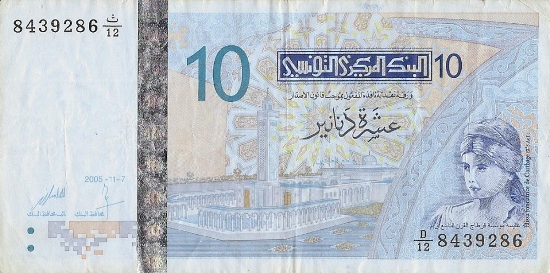
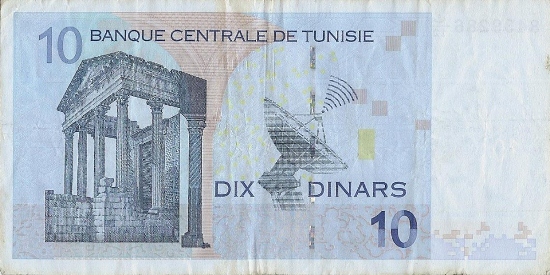
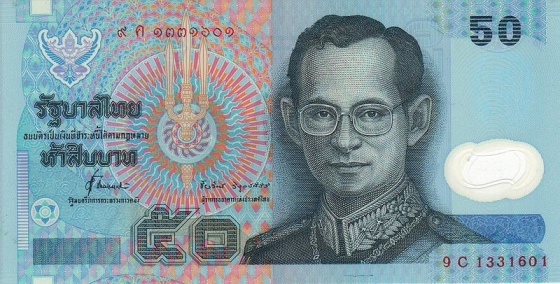
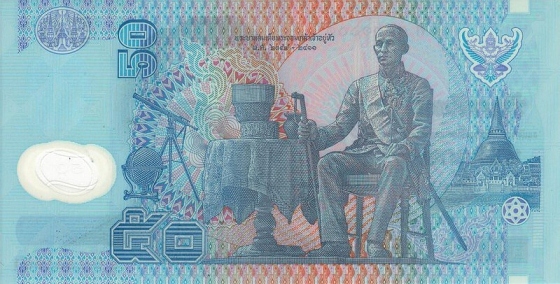

 These Swiss 1000 francs notes are part of a series which has been chosen by the
These Swiss 1000 francs notes are part of a series which has been chosen by the 